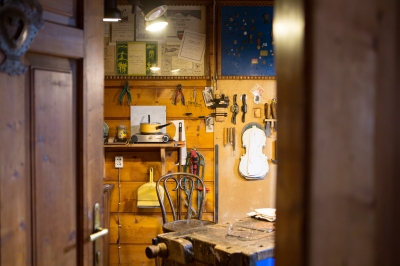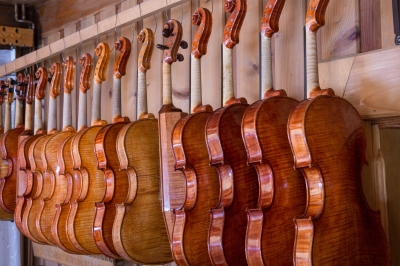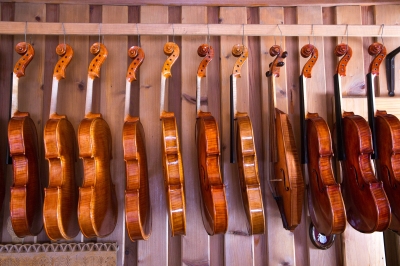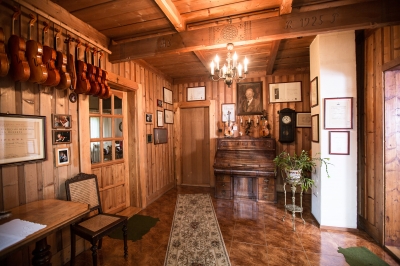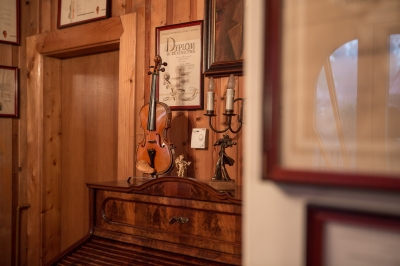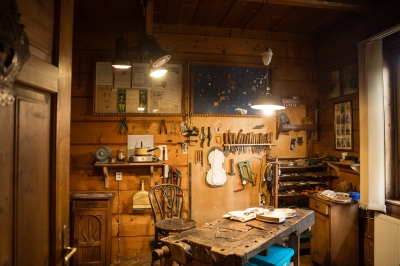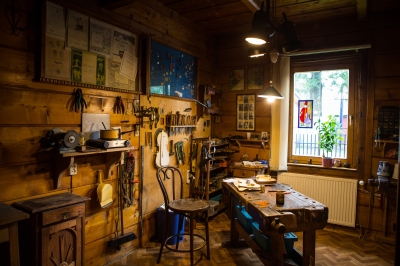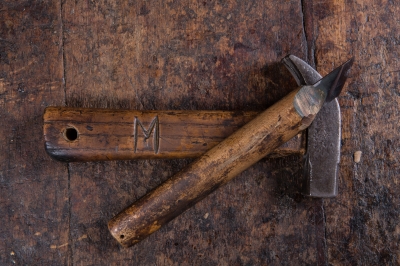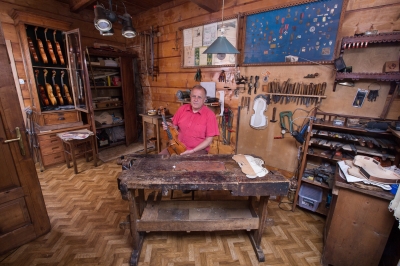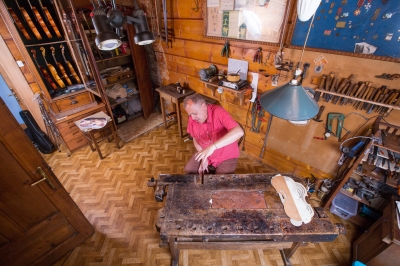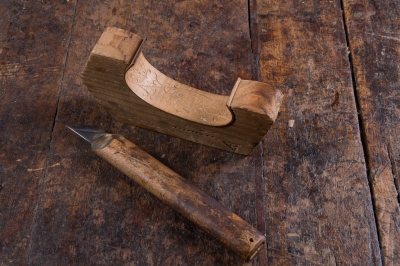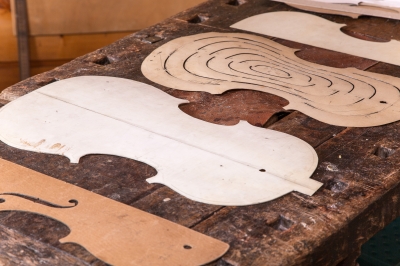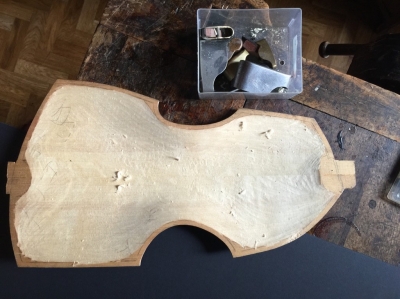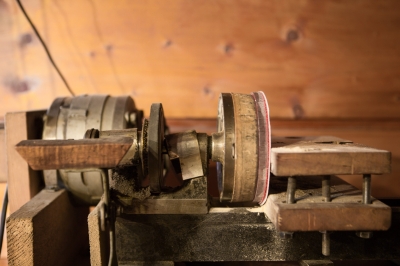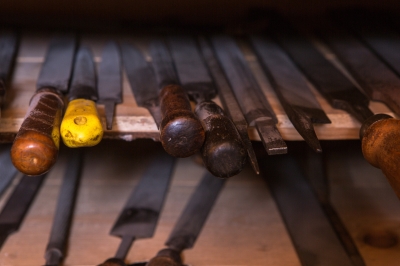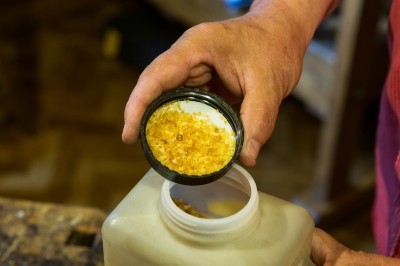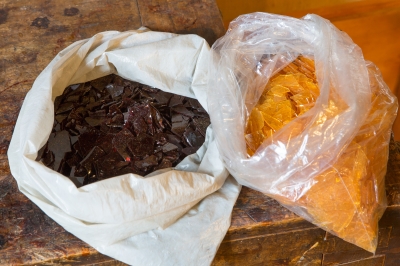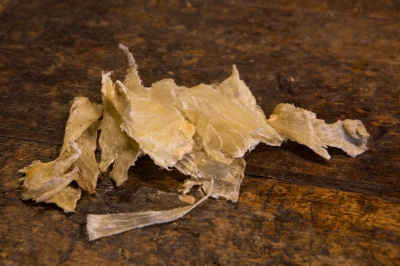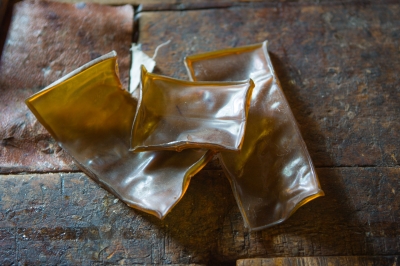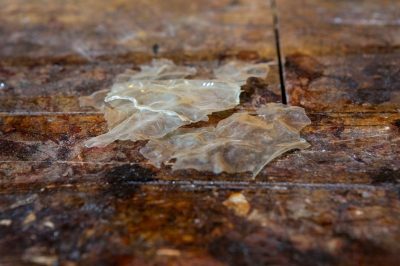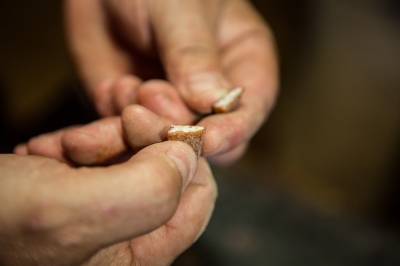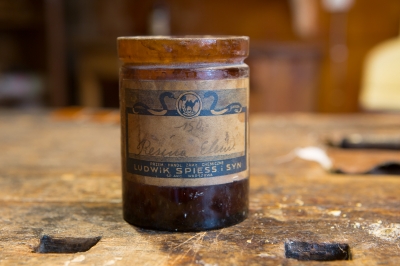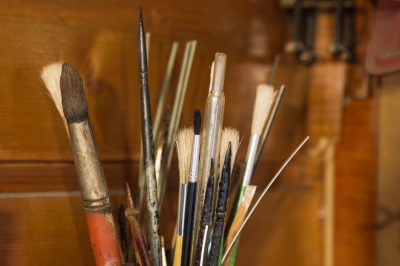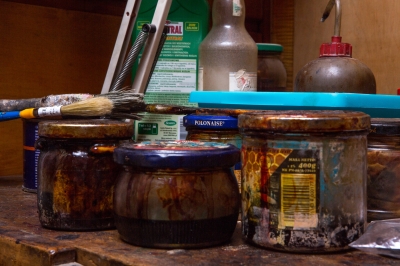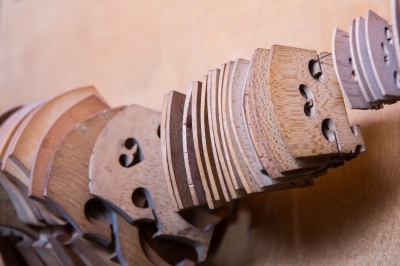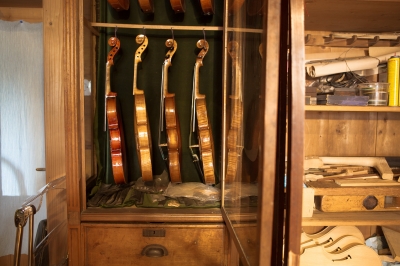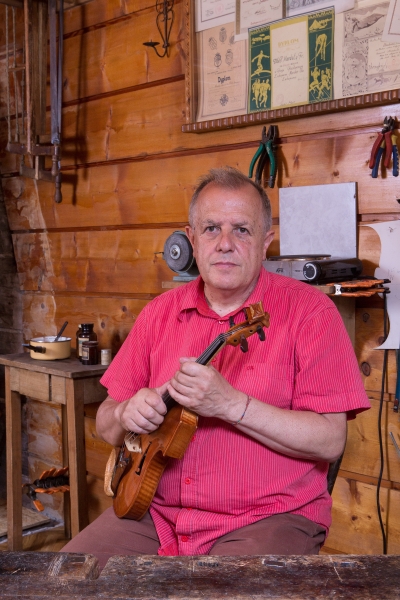A luthier’s workshop
A luthier’s workshop is more than a workroom where stringed instruments, or chordophones, and bows are made or maintenance work is done. It is also a mysterious and magical place where for centuries ideas have been exchanged and debated concerning different constructions, materials, tuning methods and, especially lately, diverging from the classical models devised by luthiers in the second half of the 18th century.
A great many academic papers and theses have been written about artist’s studios, or workshops, the authors, be they art critics or artists, trying to render the atmosphere of a place where artworks come into being. The topic, seemingly trivial, is approached from different perspectives. The description depends on the studio’s location and specialisation as well as on whether it is provided by a theoretician or an active artist. Theoreticians usually consider the workshop from an academic angle, discussing its organisation, equipment and supplies. It their texts, people linger in the background, almost as a mere addition to the inanimate apparatus. In contrast, active artists or authors with considerable artistic experience treat the place not simply as a workroom where a craftsman earns his living but, first and foremost, as a place where the creative act happens, where concepts become a reality and where artworks attain an existence of their own. If, indeed, it is a place where the profane represented by material objects meets the sacred epitomised by ideas, concepts, cultural and historical values involved in instrument making, a workshop must be understood in broader terms than the original sense of the word. A workshop cannot be defined once and for all. It means different things depending on type of artistic activity it accommodates, with a variety of artistic, intellectual and craftsmanship issues coming into play.
The description of a luthier’s workshop that I am going to furnish is deeply personal and full of emotion. After all, I will be discussing my place of work, my family home and my past, especially the thirty years I spent working as a luthier side by side with my father, Franciszek Marduła, to whom I owe my beautiful and fascinating line of work.
From furniture making to making violins
Luthier workshops would often evolve from high-end carpentry shops as the latter produced more and more sophisticated furniture. Wood was and still is the main material used to make both furniture and chordophones and so many luthiers would start their careers as furniture makers. In the Middle Ages (11th–12th century) many luthiers were in fact musicians making instruments for their own use. As a consequence, musical instruments of the time came in all shapes and sizes as no canon of as regards their construction and ergonomic properties applied. Many luthier workshops also started off as rural carpentry and instrument workshops whose clientele consisted mainly of folk musicians. In the late 19th century many workshops of this type still operated in the Polish territories, especially in regions with a highly developed music culture (Kujawy, Mazowsze, Silesia, Wielkopolska, and Małopolska where the practice of building bagpipes was also widespread). A rapid development in wood processing technology, advancement of performance techniques, rising expectations on the part of musicians and the philosophical framework of the Renaissance and the baroque period resulted in massive technical and stylistic improvements in the making of chordophones. Unfortunately, the 19th century with its social and economic transformations saw the majority of top luthier workshops in Europe closing down. Their place was taken by manufactures, which were developing at speed across France, Bavaria, Saxony and Bohemia.
Luthier workshop at the turn of the 19th and 20th centuries
A revival of the luthier workshop took place only at the turn of the 19th and 20th centuries, mainly in France (Jean-Baptiste Vuillaume, Nicolas Lupot) and in the Polish territories, in Warsaw (Henryk Rudert, Rymwid Mickiewicz, Tomasz Panufnik, Feliks Konstanty Pruszak), Kraków (Gustaw Häussler, Piotr Kubas) and Lviv (Karol Sawicki, Stanisław Niewczyk). Canons were shaped at the time, both concerning the construction (mensur) and ergonomic properties of instruments, while luthiers were expected to display great craftsmanship as well as knowledge of acoustics and rudiments of the history of art and music. The luthier was the sole creator of the instrument, vouching for its quality with his name and expertise. Only the most talented and best-educated young luthiers could meet these strict requirements. At the beginning of the 20th century, traditional luthier workshops started to specialise. Separate bow making and maintenance shops appeared, yet many prominent luthiers still made instruments and offered maintenance services.
A unique meeting place
The workshops I remember from my childhood are places full of magic, mystique, creative passion and determination, smelling of wood and etheric resins, concealing the luthier hunched over a workbench, unwilling to interrupt his work. With my father, I visited the workshops of Poland’s most accomplished luthiers. Józef Świrek from Katowice, Piotr Kubas from Kraków, Mieczysław Bielański from Wrocław, Feliks Konstanty Pruszak from Warsaw, Stefan Niewczyk from Poznań and, naturally, my father, Franciszek Marduła, gave their workrooms a unique atmosphere. Their workshops vibrated with life, bringing together luthiers, the most accomplished musicians and cultural figures. The same can be said of luthier workshops in Cremona, Paris, Brussels, Vienna and Prague where was learning the ropes of the trade, training under experienced luthiers and soaking up the atmosphere. I am deeply moved when remembering the long conversations about art and work ethics – first my father’s, then mine – with the most recognised performing artists of the 20th century: Irena Dubiska, Wanda Wiłkomirska, Eugenia Umińska, Tadeusz Wroński, Jadwiga Kaliszewska, Kazimierz Michalik, Andrzej Orkisz, Piotr Janowski when they visited our workshop. In the late 1990s we often hosted Henryk Mikołaj Górecki and Roman Tottenberg, who frequently visited Zakopane. I will never forget the discussion, often evolving into heated debates, with the best luthiers of our times: Vladimír Pilaŕ, Přemysl Špidlen, Morassi, Nadia Mantovani, Alexander Krylov, and many more from around the world. These meetings gave impetus to stylistic innovations in contemporary European lutherie, both as regards the making of instruments drawing from on classical models and those of less orthodox design.
Before it sees the light of day, an instrument is a vision in the luthier’s mind. Sometimes it takes years and many sleepless nights before the maker decides which stylistic and technical options available should be employed to make the vision come true. Only when that difficult and exhausting process is complete, the luthier may get down to physical work.
From private apprenticeship to school-based education
Not long ago the only way to become a luthier was to become an apprentice with an experienced luthier. In the course of the last five centuries many workshops were real hotbeds of talented luthiers, the most famous of which is the workshop of Nicola Amati of Cremona, with Antonio Stradivari, Giuseppe Guarneri and Jacob Stainer following in his footsteps. Looking back at the history of Polish lutherie, great pedagogic successes must be credited to Franciszek Marduła’s workshop, which educated Poland’s most accomplished contemporary luthiers: Józef Bartoszek, Andrzej Janik, Michał Więckowski, Krzysztof Pawikowski, Tadeusz Słodyczka, Jerzy Piórko, to mention just a few.
Since the 1950s, when luthier classes started to be offered in Polish schools (first luthier programme was started at Zakopane’s plastic arts secondary school), the teaching process has no longer been taking place at a private workshop but a school workshop where aspirant luthiers learn the principles of acoustics, fundamentals of art history and the basics of drawing, painting and sculpture. Today in Poland, those willing to become luthiers may learn the ropes of the profession in secondary schools in Zakopane and Poznań, and at the Academy of Music in Poznań. Graduates of these institutions make up nearly 90% of the members of the Union of Polish Artist Violin Makers, making Polish lutherie one of the best in the world.
Inside a luthier’s workshop
Most private luthier workshops typically have at least two adjacent rooms: a workroom and a reception room, as well as a small room where the most basic woodworking devices are stationed and a storeroom for tonewood. The workroom is usually small and, depending on a given luthier’s disposition, more or less messy, which gives it its distinctive character. The workroom brims with tools, utensils, basic materials used to make instruments, fragrant resins and natural dyes. It is there, at his workbench, where the luthier employs his experience and expertise to turn a few pieces of wood into a violin whose small body conceals an infinite wealth of sounds. Most luthier companies grant the privilege to enter this space only to a select group of clients.
In the reception room finished instruments are displayed for potential buyers to inspect, while restored violins, violas, cellos and the like wait to be collected by owners. That is also where instruments are first tried for their sound and where all arrangements concerning purchases and maintenance services are made. The woodworking room and the tonewood storeroom are usually located in different parts of the building (attic and basement) and are inaccessible for clients, mainly for safety reasons.
Types of tonewood
Typically two types of wood used in the making of instruments: Picea abies, or Norway spruce, with its distinctive resin fragrance and Acer pseudoplatanus, or (maple) sycamore. Also used are Abies alba, the European silver fir, Acer platanoides, or Norway maple, and birch (Betula), which has a characteristic sweet syrup smell. Even more atmospheric are the smells of exotic woods, such as ebony, rosewood, mahogany or the wood of the extremely toxic pernambuco tree, which are used to make components of instruments and bows, such as pegs, fingerboards, nuts, intarsia, bow sticks and frogs.
Norway spruce (Picea abies), which grows in places situated above 800 m a.s.l., is native to Europe’s mountainous regions, namely the foothills of the Alps and Carpathians. Those regions yield the best tonewood in the world. Thorough dendrologic studies carried out in the 1980s showed that it was spruce from the Tatra and Beskidy highlands that had been used by the prominent Kraków-based luthier dynasty started by Marcin Groblicz I. Tatra spruce might also have been used by Mateusz Dobrucki. The timber was floated on the Vistula river and its affluents to Kraków, then Warsaw and finally the seaside city of Gdańsk. Similar methods were used in Italy, where spruce timber was floated from Alpine foothills on the Po river to Cremona, Italy’s largest luthier centre, and on Lake Garda to Brescia.
Sycamore was obtained from the forests in the Beskidy and Bieszczady mountains. Already before World War II, sycamore was also imported from Romanian Bukovina. Podtatrze (Podhale, Orava, Liptov and Spiš) has been rich in hazel spruce (“Hazelficht”). I know from my father and my own experience that there are a few places where this spruce variety naturally grows in the Tatra mountains. These are Łysa Polana (more specifically Łysa Skałka), Polana Huciska (at the foot of Klinowa Czuba), Staszkówka (Głębokie), Łężna Dolina and Ciemne Smreczyny, and Kopy Sołtysie. In the interwar period these places provided wood for local luthiers and newly established lutherie classes at the Zakopane Woodworking School.
Spruce and sycamore are two basic types of tonewood used to make stringed instruments. Spruce is used to make the belly, bass bar, sound post, rib lining and rib garland blocks. Other elements of the instrument: the back, rib garland, neck and scroll are made of sycamore.
Choosing the right tonewood
Until the end of the 20th century Polish luthiers would look for tonewood in its natural environment, that is in a forest or a timber store. When I was a young luthier I would roam the woodlands of Podtatrze, Żywic Beskid, Silesian Beskid, Makowski Beskid, Sądecki Beskid, Niski Beskid and Bieszczady, first with my father and beginning from the 1980s with my colleagues, searching for timber of the right quality. We set out on our expeditions in late autumn and winter, only when trees are “dormant”, that is when their moisture content is around 30%. I will never forget these trips: we entered the wilderness knowing that we were present at the beginning of something that did not yet have any shape or form. Often the weather was winterly, with the bitter cold and heavy snow adding to the charm of what we were experiencing. Even today, many luthiers in Poland and elsewhere still have deposits of tonewood they picked and prepared themselves at that time. Typically, when luthiers and musicians meet, you will hear somebody asserting “I for one find the spruce from Żywiec better than that from Istebna, while the sycamore from Gorlice is superior to that from Nowy Sącz”. Each and every luthier has their own preferences as regards wood quality and appearance. Sometimes it is the client who asks for an instrument made of wood from a specific place, with specific grain or figure (mostly sycamore), or seasoned for a specific time.
Wood seasoning
Every luthier workshop has a small storeroom where tonewood is left to dry and prepared for further processing. Rounds of wood from felled trees are split or sewn into the so-called billets, which are then stacked and stored to dry for at least 6–8 years in the case of spruce or fir, or at least 10 years in the case of sycamore, maple or birch. Nowadays, this lengthy, if necessary process, has been cut short as luthiers choose to buy seasoned tonewood from specialist warehouses, located mainly in Germany and France. In Poland, you may obtain violin wood from music shops and smaller distributors. Unfortunately, there is no guarantee that the wood has been sourced and seasoned in conformity with the highest standards. Unfair merchants often sell wood that has been kiln- not air-dried, which is a process that causes minuscule cracks in the wood, affecting its tonal properties and diminishing the instrument’s quality.
Standard concerning the quality and drying times of wood are completely disregarded by instrument factories and most manufactures, which are solely concerned with the quantity and appearance of produced instruments. Consequently, the quality of the instruments is low and after a few years their playing condition deteriorates.
Rare materials and endangered species
Apart from European wood, more exotic species are also used in the making of violins. Dark ebony heartwood is used to make fingerboards, pegs, tailpieces, end pins, nuts and saddles. Ebony was also used, and is still sporadically used now, to make intrusion patterns on instruments’ sides, backs or bellies. Accessories are also sometimes made from rosewoods characteristic for their red-brownish and cherry-coloured heartwood, brick-red pernambuco tree or golden-yellow box.
All of the exotic species mentioned above, except for the box, are protected by the international convention on the preservation of fauna and flora. That is why access to those types of wood is very limited. As a practicing luthier I hope that a complete ban will not be introduced and it will be still possible to use those woods in certain situations to create new instruments and bows for the benefit of culture and without harm to the natural environment. The convention also protects materials of animal origin used by luthiers until the mid-20th century, such as ivory obtained mainly from the tusks of the African elephant and tortoise shell produced from the shells of the hawksbill sea turtle, which now is strictly protected as a species threatened with extinction. These materials may be replaced without disadvantaging the instrument and the bow in particular. For instance, cattle bone may be used instead of ivory. Tortoise shell is practically irreplaceable, yet with the good of Nature and all of us in mind, instead of bowing to the snobbish caprices of rich collectors and musicians, we may make bow frogs of ebony as tradition dictates. They are no less beautiful and noble that way.
Moulds and templates
Apart from wood, tools and utensils, in a luthier’s workshop you will see characteristic templates of violin backs and bellies, scrolls, f-holes and other elements of the violin, viola and cello. Moulds used to build the sides (or ribs) of different instruments are arranged on the shelves or hang on the walls. A workshop’s equipment and organisation is up to the owner and the owner only. There are workshops where most equipment hangs from racks and pegs to be right at hand when needed, while only the rarely used items are kept in drawers and cupboards. But I have been in workshops where everything is hidden from view, and on the workbench you will see only the tools the luthier is currently using. A single, universally applicable system does not exist, which makes every workshop a uniquely special place. Everything depends on the luthier’s temperament. Historical records and numerous extant iconographic materials show that the organisation and equipment of a luthier workshop has not changed significantly over the last five centuries. If you look around, you will notice the same collection of tools, templates, partly-finished instruments and wood waiting to be turned into new instruments.
The design
Designing a new instrument is perhaps the most exciting and intellectually challenging stage in the process of building a new instrument. That is when the instrument is actually born. (Because it is, indeed, the luthier’s child, to whom he owes respect, love and dedication until it gives off its first sound. Later, he can only hope that the instrument is handled with equal love and care by the musician and that an intimate bond develops between them during the long hours of practice and concerts.) Designing an instrument may take a few months, and it is the most creative time for the luther. For an experienced craftsman who has learnt all the steps of the process to perfection, it is not a difficult job, yet it remains fascinating. Based on plans the luthier determines the outer shape of the sound box, pegbox and scroll, the online of the f-holes, the arching profile and purfling, construction and ornamentation. At that stage, the luthier is working with nothing more than card box templates and notes made on paper. The instrument will assume its final shape over a long process in the course of which the original design will be undergoing modifications and major stylistic changes until the last moment.
Tools
While a new instrument is being designed, the workshop becomes a woodworking workroom. Enter planes, chisels, rasps, files and other more or less specialist tools, utensils and measuring rods. A dialogue, or rather a struggle, with the material starts, as despite all the experience the luthier has, he will always face new challenges. Just like the organisation of the workshop, its apparatus has not changed much over the centuries. The position of the workbench, arrangement of tools, utensils, templates and other paraphernalia is similar to that pictured in woodcuts and described in records from the turn of the 17th and 18th centuries. Today we use the same types chisels and planes, although they have been modernised over time, not always to the luthier’s benefit. Most luthiers employ chisels used in carpentry, sculpting and woodcarving. The variety and number of chisels depends on the luthier’s preferences. The tool set usually includes four or five woodworking chisels with straight edges and around a dozen of semicircular carving chisels with blades of different radiuses. We also use less typical tools, for instance small-sized planes with a flat or semicircular sole which are only two to six centimetres long. Other less common tools, no longer employed in furniture making, are drawknives used to shape the arching of the back and belly, the neck proper and graduation of the top and back. A luthier will also typically avail himself of purfling markers, thickness gauge, edge thickness markers and sound post setters.
The most important device of all are the luthier’s hands, his experience and intelligence, without which even the most sophisticated equipment would simply be useless. I remember my father’s original tool set back in the day when I was a little boy: a few simple chisels complemented with his incredible eagerness and creative passion. The fact that he lacked appropriate tools and equipment was irrelevant. If he needed a tool, he devised it himself, applying his engineering knowledge to find surprising ways of getting around the problem. I still use some of the tools he created and they serve me better then those bought from the best manufacturers.
Varnishes
After all the elements of the instrument have been put together, the luthier’s workroom turns into an alchemy workshop. Until recently luthiers made their varnishes themselves according to formulas passed from generation to generation. Two most popular varieties were spirit (resin) vanishes based on resins dissolved in alcohol and varnishes based on modified oil, such as linseed oil. Also used to this day are spirit varnishes or oil-based varnishes combined with etheric oils, amber and other fossilised tree resins.
Spirit varnishes and oil-based varnishes remain the most popular finishes used by luthiers. Their formulas have not changed for nearly 500 years. In the Renaissance they were used to finish off furniture and instruments alike. Using one’s own varnish formula or one known from the past is a recipe to achieve excellent aesthetic effect and quality: the varnish will successfully protect the instrument’s surface against any external damage. However, there are luthiers who opt to use ready-made varnishes offered by numerous industrial suppliers, despite never knowing for sure what the ingredients and quality of these varnishes is.
To prepare typical varnishes used in a luthier’s workshop one needs a whole array of natural resins that dissolve in alcohol, etheric oils and plant oils. The most numerous group are resins soluble in alcohol, including natural shellac produced from the secretion of the female lac insect (which comes in three shades: ruby, orange and lemon); sandarac; mastic; benzoin Siam; gum elemi; Venice turpentine; Garcinia gummi-gutta resin; olibanum (fragrant component of incense, native to Oman) and many more. Most natural resins are native to the Mediterranean region, which has made them very easily accessible. Many resins have also been imported from the Far East, including Garcinia gummi-gutta and benzoin Siam. In the second half of the 19th century natural resins produced by European conifers were used, yet they proved brittle and short-lived. Fortunately, they were mostly used by instrument factories and manufactures.
A key component of a varnish is a solvent in which resins may freely dissolve. Typically the solvent is alcohol (80% ABV), linseed oil, natural olive oil and etheric oils, e.g. lavender, lemon, rosemary or carnation oils, which give the varnish a characteristic, pleasant fragrance. Once the varnish has been prepared, it is spread over the instrument’s surface with a brush or wad. Usually twenty or more coats are applied.
Dyes
Varnishes also necessarily contain a range of dyes of plant, mineral or animal origin. Primarily these are products of ethanol extraction of powdered tree bark, roots, trunk, leaves, flowers, insect shells, minerals, etc. Most have a beautiful fragrance. Among the most commonly used are chips of sandal wood, logwood, ratany, common madder, saffron, curcuma, cochineal (Dactylopius coccus) native to Mexico and – until recently – Polish cochineal (Porphyrophora polonica, Margarodes polonicus), from which carmine dye is derived. Also used are colourful resins, such as the beautiful, ]red dragon’s blood from Borneo and Sumatra, the golden orange Garcinia gumi gutta derived from the same region, brownish aloe vera resin, and mineral dyes, including catechu, Cassel earth and asphalt.
Unfortunately, nowadays many luthier companies looking for an easy gain opt for low-quality synthetic varnishes and dyes whose durability is not known well. They also spray the varnish over the instrument’s surface instead of brushing it, which often effectively effaces the wood’s natural texture and diminishes its aesthetic value. Such practices also deter the maker’s creativity and have nothing to do with artistic lutherie, its principles, traditions and genuine artistry. Applying varnish is a very mundane process which requires immense experience and extreme sensitivity to colours, apart from patience and consistency: getting one coat wrong may ruin the whole work. The finishing process is very long and painstaking. First the luthier makes the varnish striving for the right texture and colour, then applies it to the surface of the instrument to achieve the right hue and the effect of the tones of colour shading into each other nicely, and finally chooses the right type of finish. Nothing is left to chance.
Last finishing touches and the first sound test
After the instrument’s surface has been finished, it is finally time to mount all the accessories, fit the strings and do the first sound test. It is na exam that the luthier takes in front of himself, the musician, collector and anybody who has seen the instrument at an exhibition or in a photo. It is a very poignant moment and a special occasion for the workshop, which turns into a small concert hall for the day. While the music resounds in the room, all of the gathered debate, sometimes feverishly, the instrument’s tonal properties, sustain, ease of sound production and the overall effect achieved by the maker.
In my workshop we call this moment a “christening”. Music and discussions fill the place until late at night, pleasing the ears and eyes of all those present. At a school workshop, the first sound test is also a celebration that gathers not only student luthiers but the whole class, the school’s management and all the teachers who play stringed instruments. There seems to be no end to the discussions, while music – usually highland repertoire, but also classical and popular tunes – fill the entire school. A creative mind never eases off: in the exact moment that one instrument is finished, an idea for a new one begins to form in the luthier’s head.
*
That is how the process of making an instrument and giving form to sound comes to its close. It is taxing yet beautiful and extremely satisfying. Instruments wait for their new owners in special display cabinets in the reception room in a prescribed temperature of around 20˚C and humidity around 60%. But it is not a solitary confinement. Both the luthier and visitors to the workshop like to try the instruments out, enjoying each one’s unique sound, colour and shape.
Maintenance
A luthier’s workshop is also where instruments undergo maintenance work to return to their original state and playing condition. Maintenance mainly consists in performing the same works that are involved in the making of a new instrument, yet there are many complex procedures done only as part of maintenance. Some maintenance tasks in the case of instruments of high historical and material value take as long as a few months, as the luthier prepares an appropriate material and decides what steps need to be taken and how fast the work should proceed. The luthier bears weighty moral and professional responsibility for the instrument entrusted to him, as well as legal liability as he may answer for any damage he causes to the historical object. Still, I am perfectly sure that most luthiers who run their own workshops would never change their line of work, even if they could chose a more profitable profession. For the majority of us it is a vocation that we simply cannot ignore.
Stanisław Marduła, PhD
